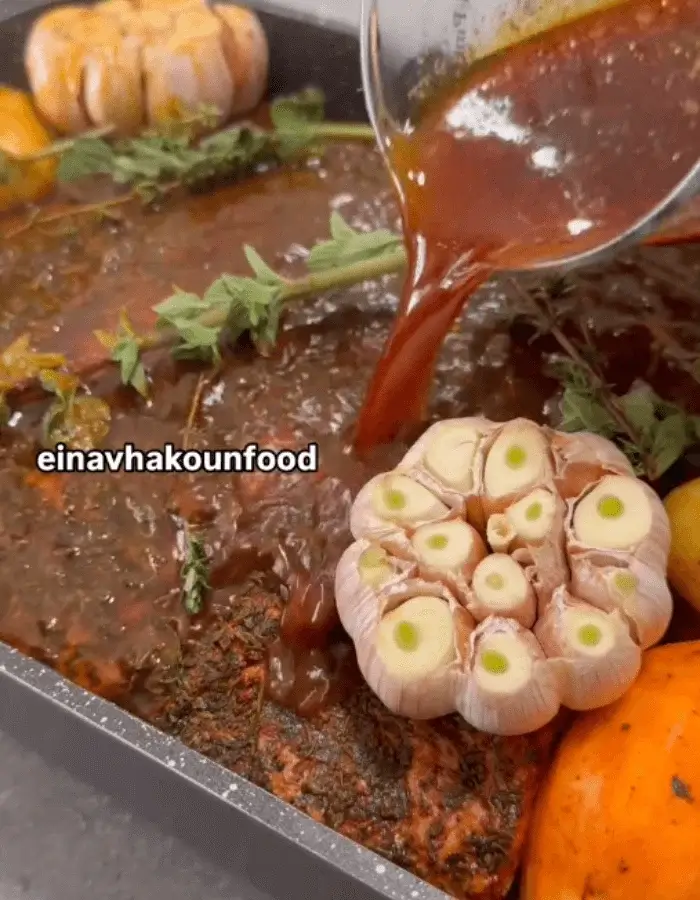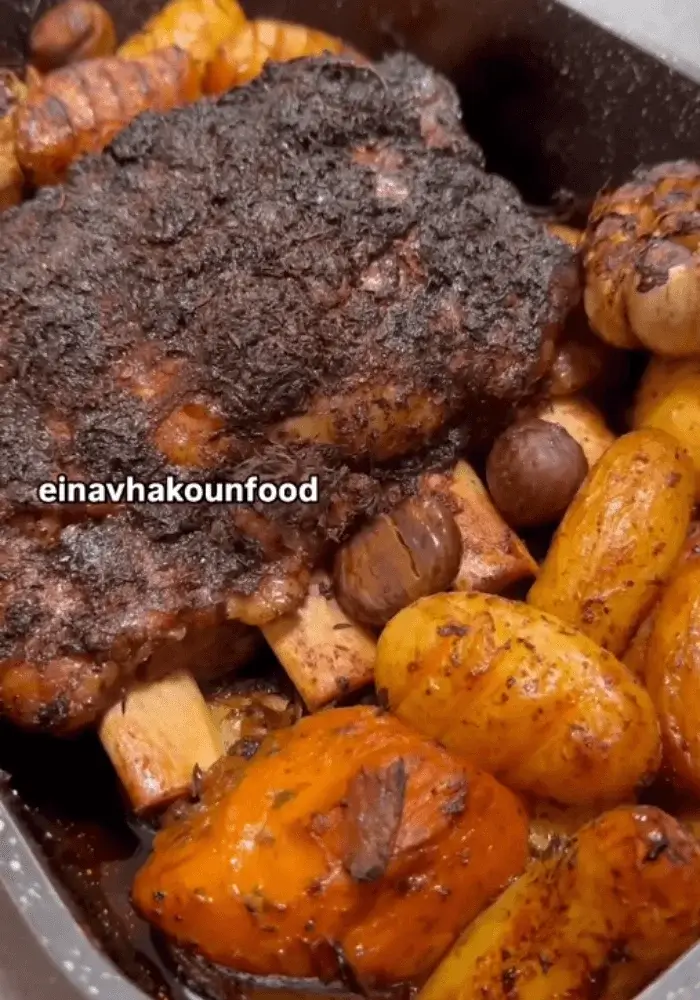Slow Roasted Beef Ribs with Potatoes and Chestnuts
We may earn a commission from recommended products, at no extra cost to you. See Disclosure.
- Mixing bowls
- Chef's knife
INGREDIENTS
- 4.4 pounds.2 kilograms bone-in beef short ribs, whole or in large pieces
- 5-6 small sweet potatoes
- 15 mini gold potatoes
- 2 whole garlic heads, halved crosswise
- 10.5 ounces/300 grams cooked chestnuts
- 1 handful fresh rosemary, oregano, and thyme sprigs
Potato seasoning:
- 3 tablespoons olive oil
- 1 teaspoon salt
- ½ teaspoon ground black pepper
- 1 teaspoon sweet paprika
- Fresh thyme leaves, to taste
Sauce:
- ¼ cup olive oil
- ¼ cup date syrup
- 1 tablespoon salt
- 1 teaspoon ground black pepper
- 1 cup boiling water
INSTRUCTIONS
- Preheat the oven to 375°F (190°C) convection.
- Scrub the sweet potatoes and baby potatoes well. Leave the skins on and score shallow slits across the tops.
- In a large covered roasting pan or Dutch oven, layer the sweet potatoes, baby potatoes, and chestnuts. Drizzle with olive oil and season with salt, pepper, paprika, and thyme leaves. Toss to coat evenly.
- Place the bone-in short ribs on top. If your ribs are unseasoned, rub them with a mixture of sweet paprika, salt, pepper, olive oil, and date syrup about 1 hour before roasting.
- Tuck the halved garlic heads around the meat. In a small bowl, whisk together olive oil, date syrup, salt, pepper, and boiling water. Pour the sauce evenly over the contents of the pan and scatter the fresh herbs on top.
- Cover with a damp sheet of parchment paper and seal with the pan lid. Bake for 40 minutes, then reduce the heat to 320°F (160°C) and roast for 3½ hours more.
- In the final 30 minutes, remove the lid and parchment paper to allow the top to brown and caramelize.
- Remove from the oven, separate the meat from the bone, and arrange on a serving platter with the vegetables, garlic, and pan juices.

FAQ
Can I use boneless short ribs instead for slow roasted beef ribs?
Yes, but the results will differ slightly. Bone-in ribs add extra flavor and moisture during the long cook time, which helps create richer pan juices and more tender meat. If using boneless short ribs in a slow roasted beef ribs recipe, reduce the roasting time by about 30 to 45 minutes, as they will cook faster and are more prone to drying out. It’s also important to check the internal temperature and texture around the 3-hour mark.

Vegetables to substitute for sweet potatoes and chestnuts
For sweet potatoes, carrots, parsnips, or butternut squash are great alternatives that also hold up well during long cooking times. In place of chestnuts, try peeled roasted hazelnuts, quartered mushrooms, or even cooked chickpeas if you’re looking for a nut-free, protein-boosting option. The key is to use vegetables that won’t disintegrate during the 4-hour cook time. In any variation, the vegetables will absorb the flavorful juices from the slow roasted beef ribs, so choose ones that complement savory, herbaceous braised meat.
How to make sure the slow roasted beef ribs are tender and not dry
Choose a well-marbled cut and keep the ribs whole rather than cutting them into individual pieces. Cook the dish tightly covered, using both parchment paper and a heavy lid to trap steam. Use a low oven temperature after the initial high-heat roast to allow collagen in the beef to break down gradually, resulting in soft, fall-off-the-bone meat. Adding date syrup and olive oil to the liquid base also prevents the meat from drying out. Finally, avoid overcooking after uncovering the pan, as the exposed meat can toughen if roasted too long.
Is it necessary to use fresh herbs?
Fresh herbs like rosemary, oregano, and thyme provide a vibrant aroma and flavor to slow roasted beef ribs, especially when added whole or in sprigs. However, if fresh herbs are unavailable, dried herbs can be used as a substitute. Use about one-third of the amount called for fresh herbs, as dried herbs are more concentrated. Add dried herbs earlier in the cooking process to allow their flavors to infuse the dish fully. For best results, combine fresh and dried herbs or garnish with fresh herbs just before serving to retain brightness.
Can I cook slow roasted beef ribs in a slow cooker?
Yes, you can adapt this slow roasted beef ribs recipe for a slow cooker. Layer the vegetables and chestnuts at the bottom, place the seasoned ribs on top, and pour the sauce over everything. Cook on low for 6 to 8 hours or on high for 3 to 4 hours until the meat is tender and falling off the bone. Keep in mind that the slow cooker won’t brown or caramelize the meat the same way the oven does, so you might want to briefly broil the ribs at the end to develop a crust. Also, reduce added liquids slightly to prevent the dish from becoming too watery.

What is the best way to reheat slow roasted beef ribs?
Place the ribs and vegetables in a baking dish and cover tightly with foil. Add a splash of beef broth or reserved cooking juices to keep moisture during reheating. Warm in a preheated oven at 300°F (150°C) for 25 to 40 minutes until heated through. Avoid using the microwave as it tends to dry out the meat unevenly. Slow reheating preserves the rich flavors and juicy texture that make slow roasted beef ribs so delicious.
Can I freeze leftover slow roasted beef ribs?
Yes, slow roasted beef ribs freeze well. After cooking, allow the ribs and vegetables to cool completely. Portion the meat, vegetables, and pan juices into airtight containers or heavy-duty freezer bags. Label and freeze for up to 3 months. To thaw, transfer the container to the refrigerator overnight. Reheat gently in the oven as described to retain moisture and flavor.
Adjust cooking times for larger or smaller short ribs
Larger, thicker ribs may require an additional 30 to 60 minutes of slow roasting to become tender. Smaller ribs or riblets may need less time, around 3 hours total. The best indicator is tenderness—the meat should easily pull away from the bone with a fork. It’s helpful to start checking the ribs about 30 minutes before the expected finish time. Adjust the cooking temperature if necessary to maintain gentle, even heat for the slow roasted beef ribs.

